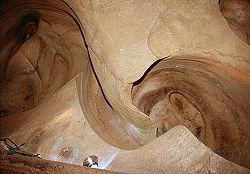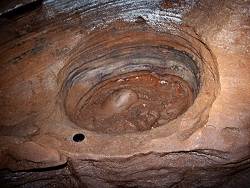Pothole
Potholes are holes in the rock which are round or oval, usually with more or less vertical walls and relatively flat bottoms, sometimes bowl shaped. They are usually deeper than their diameter.

 Grotte de Bellevue, France.
Grotte de Bellevue, France.
 Spannagelhöhle, Austria.
Spannagelhöhle, Austria.
GIANT’S KETTLE, Giant’s Cauldron or Pot-Hole, in physical geography, the name applied to cavities or holes which appear to have been drilled in the surrounding rocks by eddying currents of water bearing stones, gravel and other detrital matter.
The size varies from a few inches to several feet in depth and diameter.
The commonest occurrence is in regions where glaciers exist or have existed; a famous locality is the Gletscher Garten of Lucerne, where there are 32 giant’s kettles, the largest being 26 ft. wide and 30 ft. deep; they are also common in Germany, Norway and in the United States.
It appears that water, produced by the thawing of the ice and snow, forms streams on the surface of the glacier, which, having gathered into their courses a certain amount of morainic débris, are finally cast down a crevasse as a swirling cascade or moulin.
The sides of the crevasse are abraded, and a vertical shaft is formed in the ice.
The erosion may be continued into the bed of the glacier, and, the ice having left the district, the giant’s kettle so formed is seen as an empty shaft, or as a pipe filled with gravel, sand or boulders.
Such cavities and pipes afford valuable evidence as to the former extent of glaciers (see J. Geikie, The Great Ice Age).
Similar holes are met with in river beds at the foot of cascades, and under some other circumstances.
The term “pot-hole” is also sometimes used synonymously with “swallow-hole” (q.v.).
Hugh Chisholm ed. (1911): Encyclopædia Britannica, Vol. 11 (11th ed.) Cambridge University Press. p. 927. (public domain)
Potholes are common and widespread erosional forms. A river with high energy, i.e. a large gradient, transports sand, rubble and boulders. This material erodes the walls and bottom of the riverbed, forming rounded shapes. Whirlpools, however, cause the water to always transport its load in a circle at the same point, thereby drilling a large hole in the riverbed. This creates a pothole. The resulting potholes are as varied as the whirls themselves. They are usually round or oval, but can also be spiral-shaped and usually have a vertical wall. They are typically much deeper than their diameter and resemble boreholes. The bottom is often flat, but three holes arranged in an isosceles triangle (offset by 60°) at the bottom are also typical. These in turn can form sub-potholes.
Depending on their formations this kind of holes is found everywhere where water flows. Gorges and river caves are a good place to look for them. Potholes are common in caves, as many caves or at least parts of cave systems were formed by flowing water. But they are not restricted to caves, and they are not even typical karst features. Potholes are found in all kinds of rocks and everywhere on earth.
Often the bigger rocks which are turned and swirled around by the water and helped to drill the hole cannot leave the pothole again and are now lying on the bottom. They were rounded by the movement and have a spherical form. They are sometimes called millstone or drillstone, or simply pebbles.
The synonym Kolk is a special case because it is used for two related but different things. In addition to potholes, it is used to describe small lakes or bogs, especially in northern Germany, and sometimes also dry hollow forms. These are also formed by whirls in flowing water, but usually in unconsolidated rock, resulting in a rather shallow, bowl-like pit. If the walls are still steep at the beginning, they flatten out relatively quickly.
Many potholes are found at the mouth or the former location of glaciers, where centuries of flowing melting water formed them. This is such an important subgroup that we have a separate page for it:
Potholes have numerous names, an overwhelming number of synonyms. Potholes are also called pot, kettle, stream kettle, giant’s kettle, giants cauldron, swirlholes, dolly tub, evorsion, hollow, rock mill, churn hole, eddy mill, and kolk or colk. It’s unclear why there are so many different names, but in most cases these are regional names. They all have in common that they describe either the form of a cauldron or kettle, or the way they are formed by milling around. It seems a century ago the term Giant’s Kettle was the most commonly used term in scientific literature, see the Encyclopædia Britannica entry above.
Today the term pothole is the most common name for those holes, and so we finally decided to use this term on showcaves.com. This was a hard decision, as there are various drawbacks:
- British cavers will have some problems with this term, they use it for daylight shafts, vertical shafts which reach the surface, and sometimes even for a cave. Its part of the name of caving clubs, and potholing is a synonym for caving. Many texts on showcaves.com were written by Tony Oldham, who uses the term this way.
- Pothole is associated with holes in roads, this is the normal use of this term.
- The Wikipedia disambiguation page lists six completely different uses for pothole, and five of them are related to geology, but different.
For many years we used the term dolly tub, which was quite practical as this term was not used for anything else and thus the danger of a mixup was zero. This term is officially listed on the UIS Caver’s Multi-lingual Dictionary as Concept ID 91. But unfortunately the dictionary and showcaves.com are the only websites which actually use this term. In other words, there are exactly two sites which use this term, but Wikipedia or other encyclopedias are not aware of this term. While it is legitimate to define a term, we prefer to use the term which is already in use by other authors. In this case this has some drawbacks, but we think it’s the best solution. To minimize confusion, we replaced all occurrences of "potholes" by daylight shaft.
 Glacial Mill
Glacial Mill Search DuckDuckGo for "Pothole Kettle"
Search DuckDuckGo for "Pothole Kettle" Kolk (vortex) - Wikipedia (visited: 16-SEP-2021)
Kolk (vortex) - Wikipedia (visited: 16-SEP-2021)
 Index
Index Topics
Topics Hierarchical
Hierarchical Countries
Countries Maps
Maps